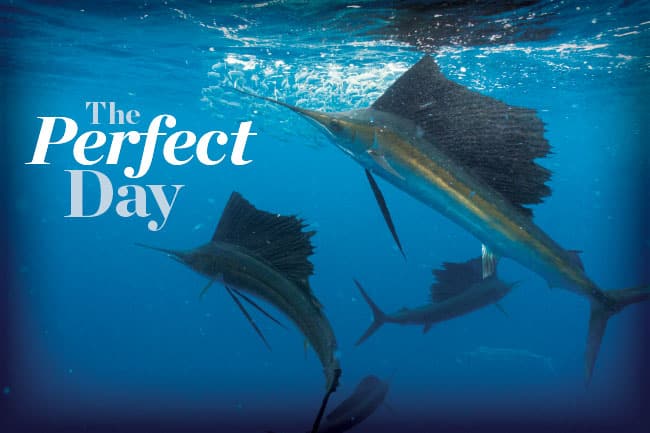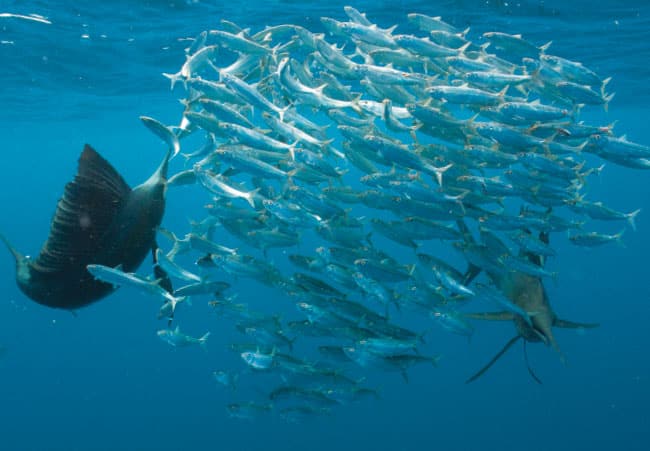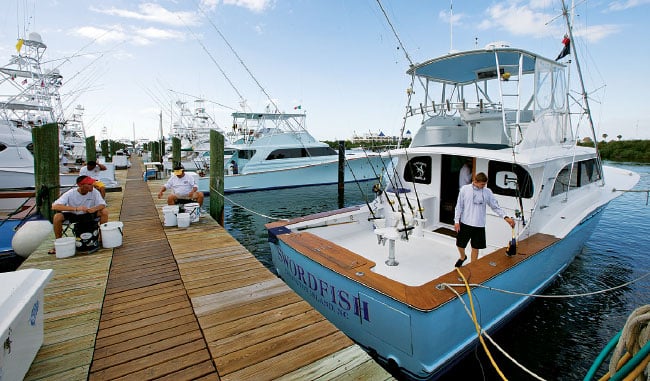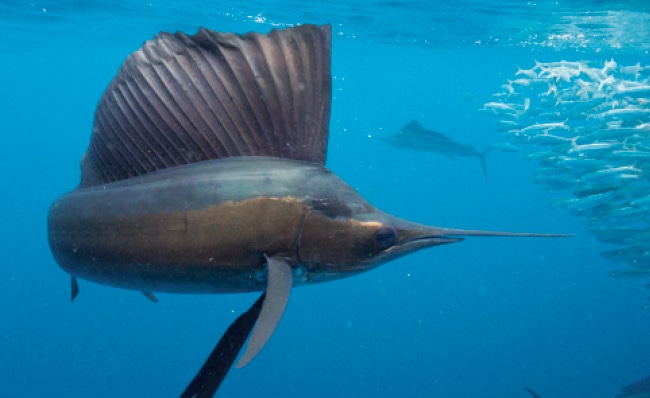
I’ve spent a lot of time during the last 50 years in, under and around the water, especially in South Florida and the Keys, but I’ve never experienced anything like the day I recently had in Isla Mujeres, Mexico. It all came about quite unexpectedly.
During a recent visit to Tropic Star Lodge in Panama, I ran into Jimmy Nelson and his Gaff Life television crew. They were there to film a series of episodes on Tropic Star for NBC Sports. I was also on a photo mission, and our conversation flowed casually from fish to cameras to techniques to destinations. At some point, I mentioned that one of my goals was to get back to Isla Mujeres and try to take some underwater photos of sailfish balling bait.
I’d been to Isla Mujeres with Tim Choate back in 1981, trying to set an IGFA fly record for Atlantic sailfish on 6-pound tippet. We caught a sail that would have been way over the existing record, but to our dismay, we couldn’t find a certified scale on the entire island. Nevertheless, it was a fun trip with lots of sails raised and caught, but not once were they ever “balling bait.”
Fast-forward some 30 years, and the growth of the sport-fishing industry in Isla Mujeres is off the charts. It is now the No. 1 place for Atlantic sailfish from mid-January through March. Catches of more than two dozen sails a day are common, and several videographers have recorded some outstanding action after coming across packs of sails working balls of sardines. The sight of sails working a baitball is a rarity in most parts of the world, but you have a pretty good chance of seeing it happen in Isla Mujeres. As luck would have it, Nelson said that they were filming a show in Isla Mujeres in a few weeks and invited me to tag along. He didn’t have to ask twice!
Back to Mexico
I met Nelson and his cameramen, Mark Soussou and Xavier Groenendyk, at the Miami airport for the short hop to Cancun. Upon arrival, we flagged down a van and headed to Puerto Juarez for the 20-minute ferry ride to Isla Mujeres.
Brant Wise, owner of Swordfish Sportfishing and the 53-foot custom Carolina sport-fisherman Swordfish, would be angling with us. Capt. Jim Ashley and Swordfish spend most of the year on the Outer Banks in North Carolina, but venture down to Isla Mujeres for the winter sailfish run, from January through March. Wise met us when we stepped off the ferry. The seas were flat and calm — too good to be true, of course.
Wise’s local contact and overall “fixer,” Tony Poot, also met us at the dock and brought us to our hotel and then to the boat to unload what seemed like several hundred pounds of camera equipment. Poot turned out to be invaluable to us during the trip, and he arranged dinners at Freddy’s, his father’s restaurant, which was only a few doors down from our hotel. Everything seemed to be flowing smoothly until about 10 a.m. the next morning.

Our first day on the water started out nicely, albeit with a warning that a front was moving into the area. Our run to the fishing grounds took about an hour pushing through 2- to 3-foot seas, and within the first hour of trolling, we raised six sails and caught two — then everything went south! The wind arrived ahead of schedule, the seas shot from 3 feet to 8 feet, the fishing shut down completely, and by 11 a.m., it was just too miserable to stay on the water. Heading in was pretty much a no-brainer, and by the time we reached sheltered water, the wind was blowing 30 knots and the seas were pushing 12 feet. The next day, the wind never let up, and we stayed at the dock.
Day three dawned with civilized winds and seas, but a whole day of fishing raised two sails that didn’t eat and a 40-pound kingfish that managed to stay attached to a circle hook on a mono leader. We never even saw a frigate bird.

Nelson was supposed to have his show wrapped up after three days so that he could go diving on the last day and then shoot his interviews and go home. With nothing close to a show, he had to make a decision about the diving part. Wise announced that he and I were going fishing, and that Nelson had little choice but to put all of his eggs in one basket and join us. It turned out to be the best decision Nelson ever made. We left the dock at 7 a.m. and headed out into relatively calm seas, but the sky was dark and cloudy. We ran a good hour north (I think) before we set out the dredges, teasers and ballyhoo. It didn’t take long before we had our first sail in the air.
Soon after, we started spotting frigate birds working bait on the surface. The only reason that the bait would be up on top like that would be predators attacking from below! As we trolled by the birds, we saw multiple sails working baitballs, their fins slicing through the surface under the diving frigates. We quickly caught and released four more sails, with Nelson and his crew piling up the footage until we got the OK to get in the water.
The water was blue, but a bit dirty, and the cloud cover hadn’t lifted. This made still photography difficult — we had to use slower shutter speeds and larger apertures — but it may have been the cloud cover that brought the fish to the surface. Nelson used an HD video setup, and I used my Sony Nex-5N in Nautica housing for still photos. We both perched on the gunwale while Ashley tried to find us some birds that weren’t being hassled by any other boats. Getting run over wasn’t really in our game plan. Neither of us really had any idea what was going to happen once we were in the water, but we were ready.
We soon spotted a flock of frigates far away from the other boats and raced over. What followed was the most amazing experience I’ve ever had on the water. Ashley pulled up next to the ball of bait, cut the engines, and Nelson and I dropped into the water. We had to chase down the birds until we got within underwater sight of the sailfish. Gradually, I could make out dark shapes in the distance, and my adrenaline kicked in enough to let me catch up to the action unfolding before us. As I came closer, the entire ball of bait rushed over and hid underneath me. Amazing.
Nelson and I were never very far apart, because the bait kept trying to put us between them and the marauding school of sailfish. My biggest challenge was getting far enough away from the ball to get some decent photos.
Coordinated Attack
During the hour that we floated along, I think I learned more about sailfish than I’ve learned in more than 40 years on the water. A cone of around 30 sails worked at the ball of sardines in a definite pattern. No more than three sails would herd and attack the bait at any one time, and most of the time it was only one. Looking down, I could see the rest of the sails fanned out below us. The sails feeding on the ball were literally colored black, while those lower down were a pale green color.
The color patterns were magical and changed constantly, but the feeding fish on the surface provided all the action. One or two sails would raise their dorsal fins and work the bait into a tight cluster and then push it to the surface just a few feet in front of us. This resulted in a sail on both sides of us, dozens of sails below, and nothing but air and frigate birds above. The designated eater would then stick its bill into the baitball and whack a sardine or two. It was a very controlled and specific act — not a mad rush to bite the bait. There were scales floating all around us, and I could see dozens of wounds on the baitfish, so there were a lot of hits that didn’t produce a meal, and the process had been going on for a while.

The bill slash would usually stun a sardine or two, or at least separate them from the school, whereupon the attacking sail (and only that sail) would either grab the bait or, if necessary, run it down. The sails showed astonishing speed and agility when running down and grabbing the baits. If the separated sardine eluded the first attack and got too far away from the baitball, it suddenly became fair game for the rest of the sails, but that didn’t happen very often.
When the sail caught the sardine, it initially held it horizontally in its mouth — head and tail sticking out on opposite sides — and then started chewing it. Actually, the sail was probably crushing the sardine to soften it up and reposition it so that it could be swallowed headfirst. The sailfish remained pretty much motionless during the chewing phase, and then moved off as soon as the bait was swallowed. The whole process took a lot longer than I’d expected, and it emphasized how important the drop-back is when trolling ballyhoo. You really can’t drop back too long, and if you come tight too quickly, the hook won’t even be in the sail’s mouth.
We snorkeled with this school of sailfish for more than an hour. The bait kept trying to hide between Nelson and me, the sails stayed with us, and the boat drifted along right next to us. At one point, the sardines got between Nelson and his camera, so close that he actually grabbed one and hand-fed it to a sail. Several times, I’d swim away from the baitball, turn and swim back to it, only to have a sail herd the bait right into me. I’d be trying to get a photo of the baitball, it would suddenly split around me, and I would find myself nose to nose with a sailfish. The sails must have considered us just part of the package, because they were not afraid to swim within inches of us, but none of them ever touched us. Everything was moving fast, but it never moved very far away from us. It seemed like a ballet unfolding for our personal pleasure, and it was mesmerizing.

Wise and the crew on board managed to drift ballyhoo back to us every so often, hooking several sails while we were in the water, but they were still getting antsy. It’s illegal to cast live baits in Isla Mujeres water, and American boats aren’t even allowed to fish with spinning rods; so we were taking a good chunk out of Wise’s last day of fishing, and, after all, it was his boat! Eventually, I filled up a 32-gigabyte memory card and had to return to the boat. Nelson followed a few minutes later. We were both so excited that we could barely speak. Nelson’s Gaff Life show is going to be spectacular.
We fished the rest of the day, releasing a total of 20 sails out of probably 30 bites. Around 4:30 p.m., with the fishermen pretty much worn out, we found one last baitball. The water was a lot dirtier, a bit green, and the sun was pretty low on the horizon, but at least it was out. I figured that this might be my last chance to ever photograph feeding sailfish, so I managed to con my way back into the water. Nelson let Groenendyk handle the video this time, and over we went.
When we caught up with the frenzy, we found a very small baitball. It moved right over to me and then wouldn’t leave. It circled just a few feet in front of me until my camera battery failed and I had to call it quits. Later, Groenendyk told us that as soon as I left, the sails went crazy and ate every last sardine within a matter of minutes. At the end of the day, we had 20 releases, more than an hour of amazing video, and more than 1,000 still photos. Best day of my life on the water!







